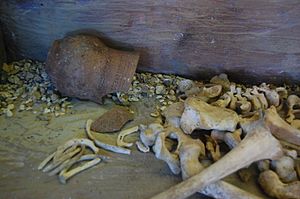Aymestrey burial facts for kids


The Aymestrey burial was a very old grave found in Aymestrey, a village in Herefordshire, England. It was a special type of stone box, called a cist, that held the remains of a child. This burial is connected to the Beaker culture, a group of people who lived thousands of years ago. Today, you can see a recreated version of this ancient grave and the objects found with it at the Leominster Museum.
How Was the Aymestrey Burial Found?
In June 1987, workers from a company called ARC were digging at a gravel quarry in Aymestrey. A gravel quarry is a place where people dig up gravel, which is used for building roads and other things. As they were working, they found a hole with stones lining its sides. Inside, they could see human bones.
The workers quickly called in archaeologists from the Hereford and Worcester County Council. Archaeologists are like history detectives who study old objects and places. They carefully dug up the site. They discovered a stone-lined pit that held the body of a child. The child was lying on its left side in a foetal position, which means curled up like a baby before it's born.
Next to the child's body, the archaeologists found two important items. One was an earthenware bell beaker. This was a type of pot shaped like a bell, often used for drinking. The other item was a flint knife. Flint is a hard stone that can be shaped into sharp tools. Experts believe this burial dates back to the Early Bronze Age, a time when people started using bronze to make tools and weapons.
Where Was the Burial Site Located?
The place where the Aymestrey burial was found is very interesting. It lies between two Iron Age hill forts. Hill forts were large, fortified settlements built on hills, like ancient castles. These two hill forts are called Pyon Wood and Croft Ambrey. The burial site is also located right next to a small river that flows into the larger River Lugg.
Seeing the Burial Today
The Aymestrey burial is no longer in the ground where it was found. Instead, it has been carefully recreated as a display at the Leominster Museum. This means you can visit the museum and see how the burial looked when it was first discovered. The museum display includes the child's bones, the bell beaker, and the flint knife, giving visitors a glimpse into life and burial customs from the Early Bronze Age.

